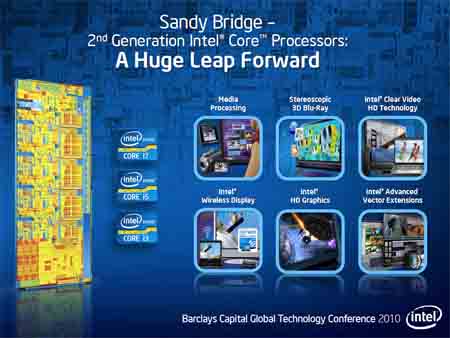Intel Sandy Bridge dual-cores coming soon

Intel's latest Sandy Bridge processors have officially been available since the Consumer Electronics Show in January. But the first chips were quad-cores for high-end desktops and larger laptops. The dual-core versions were to follow in late February or early March. A design flaw in the supporting chipset delayed things a bit, but Intel and its customers fixed the problem within a few weeks and it now looks like the dual-core laptops are ready to roll.
This is important because the vast majority of laptops use dual-cores. They generate less heat so they can fit in smaller laptops, they deliver longer battery life, and most important, they cost less. By all accounts, the second-generation Core i3, i5 and i7 processors are a significant upgrade, so if you plan to buy a new notebook, it makes sense to hold out for a couple more weeks. (Intel refers to these Sandy Bridge chips as "second-generation" to distinguish them for the first 32nm Westmere processors released a year ago.) A few companies are already taking orders for mainstream laptops with second-generation dual-core processors, but most delivery dates seem to be around the end of March.
As usual, Apple is the exception. Apple was the first to release a dual-core Sandy Bridge in its updated MacBook Pro line. The 13-inch MacBook Pro starts at $1,199 with a second-generation 2.3GHz Core-i5 dual-core processor. The larger 15- and 17-inch MacBook Pros use the quad-core chips, and the 13-inch model is also available with a quad-core starting at $1,499 (here's CNET's review of the latter configuration). These models are available now online and in Apple stores.
This morning Dell announced that it would expand Sandy Bridge across its entire product line, starting with new Inspiron line of mainstream laptops and desktops next week. These will be followed by new business PCs including Latitude laptops, Optiplex desktops and Precision workstations. The company also hinted at an ultra-slim notebook "that will combine beauty and brawn in a form factor that will excite and delight" to be released in April. Dell recently discontinued its Adamo ultra-slim laptop.
Dell is already taking orders on high-end XPS and Alienware-branded laptops with Sandy Bridge processors. The XPS 15 starts at $1,049.99 with the 2.7GHz Core i7-2620M dual-core processor. (Most second-generation Core i7 mobile processors are quad-cores, but in a confusing move, Intel released one dual-core mobile part as well.) The XPS 17, which starts at $899.99, is available with second-generation Core i5 and Core i7 dual-core chips. The Alienware M17x, a gaming laptop, starts at $1,499 with quad-core Sandy Bridge processors.
HP was quick to add Sandy Bridge to special Quad Editions of the Pavilion dv6 and Pavilion dv7 laptops. The dv6t Quad Edition is currently $999.99 with a 2.0GHz Core i7-2630QM and AMD's Mobility Radeon HD 6570 graphics with 1GB of graphics memory to drives its 15.6-inch display. The dv7 Quad Edition, which has a 17.3-inch display, starts at $1,099.99 with the same tandem.
Last month HP announced a new design for the Pavilion laptops that gave them more of the look and feel of the upscale Envy line. The new models, with Sandy Bridge processors, will be available sometime this spring. Until then the Pavilion dv6 and dv7 will continue to use the older Intel processors, or in some cases AMD Phenom IIs. Most recently HP said it was updating its EliteBook p-series and ProBook s-series and b-series to include Sandy Bridge dual- and quad-core processors. These business notebooks will be available starting March 15.
Lenovo has already announced updates to its ThinkPad T, L and W series laptops--all of which should be available later this month. Earlier today Engadget posted a PDF with details on what appears to be a new X series. If it's accurate, the ThinkPad X220 will have a new 12.5-inch display (including an optional "extra-bright" IPS display with wider viewing angles), second-generation Intel Core dual-core processors, and several hard drive and SSD options.
Finally, Sony just started taking orders on its redesigned VAIO S series, a 13-inch laptop that starts at $969.99 with a 2.3GHz Core i5-2410M dual-core and AMD's Radeon 6470M graphics.
AMD seems to be getting some traction with its new E-Series APU, or Accelerated Processing Unit, which like Intel's latest processors combines a CPU and graphics processor. But the E-Series is a low-power chip designed for netbooks and less-expensive ultraportables, so it is not really a direct competitor to the more powerful Sandy Bridge.
Later this year AMD will release its Llano APU, which will provide more direct competition. Last week, AMD's Godfrey Cheng released a video showing Llano's performance versus Sandy Bridge on specific graphics-intensive tasks. When it arrives, we'll be able to see how it really stacks up to Sandy Bridge in mainstream and high-performance laptops.
